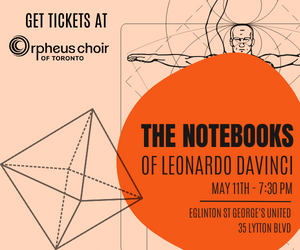If there’s one thing I like as much as sitting in my easy chair with my feet up listening to music, it’s sitting in that chair reading a great book. There was a time when my very favourite thing was doing both at once but I must confess that as my 60th birthday rapidly approaches it’s getting harder and harder to multi-task in that way. So what is now a special treat is settling into the Lazy Boy and curling up with a book that takes me on a musical adventure.
Books: I first encountered the novels of Richard Powers in 1991 when my successor at CKLN-FM, local choral director and Georgian vocal specialist Alan Gasser, gifted me with The Gold Bug Variations, a spectacular tour-de-force interweaving themes of Bach’s counterpoint and Poe’s fiction with strands of molecular biology. It is a multi-layered masterpiece that juxtaposes two love stories, one set in the present and one in 1950s academe where the search for the DNA genome was in full swing. The eminence grise, always present but never mentioned by name, is a certain Canadian pianist whose youthful 1955 recording of Bach’s Goldberg Variations stood the music world on its ear. If you haven’t read it I urge you to do yourself a favour and pick up a copy at your earliest convenience.
Since that time I have read and re-read all ten of Powers’ outstanding novels which, beginning in 1985 with Three Farmers on Their Way to a Dance, have appeared every two or three years to much critical acclaim (and to my delight). Some years ago in this column I raved about Powers’ The Time of Our Singing (2003) in which, among other things, the development of the historically informed performance practices of the period-instrument movement was juxtaposed with just about every significant political happening of the 20th century through the eyes of a very special family whose members always seemed to be present, at least on the periphery, at these events. Again I would urge you to check it out.
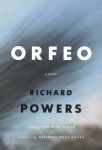 Powers’ subject matter is extreme in its diversity, from medical research and psychological disorders, to nuclear physics, environmental concerns, advanced technology, forced confinement and terrorism. Music is present in one way or another in most of his books, but for me it is those in which music is central to the plot that are the most satisfying. It was therefore a real pleasure to find that, after a publishing hiatus of nearly five years, his 11th book – Orfeo (HarperCollins ISBN 978-1-44342-290-1) – returns to the double theme of musical composition and genetic engineering. The main character is a composer, Peter Els, who comes of age in the 1950s and 60s, a tumultuous time when the post-war generation took Western art music to the very brink. I won’t go into much detail of the plot, but will say that we follow Els on a protracted journey from his adolescent vision of composition as divine inspiration, through academic struggles with serial constraints and avant-garde freedoms, to minimalist structures and neo-Romantic regression, with many stops and side trips along the way. Ultimately Els is at a loss as to how to take music itself any further and he eventually returns to the scientific interests of his youth. In the decades that have passed genetic engineering has blossomed and the internet has made it possible for anyone with access to a computer to build a sophisticated home laboratory. In the end the aging composer decides that writing genetic code is the future of composition and sets about writing a work for the ages using DNA itself. Through a comedy of errors this leads to his being taken for a bio-terrorist and the chase (and fun) begins.
Powers’ subject matter is extreme in its diversity, from medical research and psychological disorders, to nuclear physics, environmental concerns, advanced technology, forced confinement and terrorism. Music is present in one way or another in most of his books, but for me it is those in which music is central to the plot that are the most satisfying. It was therefore a real pleasure to find that, after a publishing hiatus of nearly five years, his 11th book – Orfeo (HarperCollins ISBN 978-1-44342-290-1) – returns to the double theme of musical composition and genetic engineering. The main character is a composer, Peter Els, who comes of age in the 1950s and 60s, a tumultuous time when the post-war generation took Western art music to the very brink. I won’t go into much detail of the plot, but will say that we follow Els on a protracted journey from his adolescent vision of composition as divine inspiration, through academic struggles with serial constraints and avant-garde freedoms, to minimalist structures and neo-Romantic regression, with many stops and side trips along the way. Ultimately Els is at a loss as to how to take music itself any further and he eventually returns to the scientific interests of his youth. In the decades that have passed genetic engineering has blossomed and the internet has made it possible for anyone with access to a computer to build a sophisticated home laboratory. In the end the aging composer decides that writing genetic code is the future of composition and sets about writing a work for the ages using DNA itself. Through a comedy of errors this leads to his being taken for a bio-terrorist and the chase (and fun) begins.
Powers is a master at describing and giving context to the examples of great music he chooses to include, and his insights are enlightening. Time and again I found myself rushing to my library to dig out a favourite recording and it was refreshing to re-visit the works in question and to hear them with “new ears” as it were. Els’ own epiphany was a recording of Mozart’s “Jupiter” symphony from his father’s collection. I chose to go back to the recording I had grown up with, an LP of Otto Klemperer conducting the Philharmonia Orchestra (now available on CD from EMI Classics). (Realizing that using full-sized 20th century orchestral forces in 18th-century repertoire is no longer politically correct, I asked Bruce Surtees for a recommendation and he suggested Jos van Immerseel conducting the Anima Eterna Orchestra of Bruges on the Zig-Zag label.) As a burgeoning clarinetist Els is introduced to Zemlinsky’s Trio in D Minor, Op.3 by the young cellist who becomes his first love. I was glad to be reminded that I had Amici’s version of this rarely recorded work in my collection and happy to have an excuse to revisit it (Summit Records). For Mahler’s Kindertotenlieder I found that I was not overly satisfied with the recordings in my collection and once again went to an expert for advice. Daniel Foley says: “Among the women, Janet Baker’s 1967 recording with the Hallé Orchestra under Barbirolli (EMI) is unquestionably the most moving interpretation of the dozens I know... My hero Fischer-Dieskau’s recording with Karl Böhm and the Berlin Philharmonic was recorded in 1963 and remastered in 2011 (Deutsche Grammophon).”
For Messiaen’s Quatuor pour la fin du temps I have many, more than a dozen, recordings to choose from, but once again I chose our local Amici ensemble. The complication was which of their recordings to select. Ultimately I decided to go with their original 1995 performance with violinist Shmuel Ashkenasi (Summit Records) rather than the 1999 recording with Scott St. John (Naxos). It was a tough choice that did not come down to the violinists, but rather cellist David Hetherington’s performance of the fifth movement, marked infiniment lent, extatique, which is fully 15 percent slower (i.e. more infinitely lent) on the earlier disc. Both his performances however are totally convincing as are those of clarinetist Joaquin Valdepeñas and pianist Patricia Parr.
For the Shostakovich Symphony No.5 I turned to a reissue of the set of complete symphonies recorded by West German Radio during the 1990s featuring Rudolf Barshai at the helm of the WDR Sinfonieorchester (Brilliant Classics). When it came to the extended descriptions of the John Cage “Happenings” Musicircus and HPSCHD I was left thinking, despite having an old Nonesuch vinyl record of the latter piece, that you probably had to have been there to really get it. I did turn back to my LP collection however for Harry Partch’s classic Barstow (Columbia Music of Our Time). As far as I can tell this is not available on CD, but you should check it out on YouTube.
I have quite an extensive collection of Steve Reich recordings on vinyl and CD, but I missed Proverb – an extended riff on Ludwig Wittgenstein’s sentence “How small a thought it takes to fill a whole life!” for three sopranos, two tenors, two vibraphones and two electric organs – when it came out in 1996. The disc seems to be out of print at the moment but is available as a digital download from Nonesuch, and again, is available for streaming on YouTube (accompanied by the following comment from Roger Brunyate: “Do read (preferably while simultaneously listening) Richard Powers’ sublime description of this piece on pages 245–254 of his new novel Orfeo.”
There are many other pieces mentioned in more or less detail during the book, including Berg’s Violin Concerto, Strauss’ Four Last Songs, Shostakovich’s String Quartet No.3 and, although not by name, Copland’s Appalachian Spring. One of the most moving moments is the description of Peter Lieberson’s Neruda Songs, written for his wife Lorraine Hunt Lieberson and premiered just a few months before her death, making the lyric “My love, if I die and you don’t” even more poignant. I found that track on YouTube, but the whole cycle of five songs is featured on a Nonesuch recording with the Boston Symphony Orchestra under James Levine’s direction. It was the soprano’s final recording.
Perhaps the most intriguing description in Orfeo is of Els’ own opera based on the Anabaptist uprising of 1534 in Münster. We are presented with a very detailed précis of this imaginary opus and its premiere which coincided with the strikingly similar events that took place in Waco, Texas in 1993. As always, Powers’ blending of fact and fiction keeps us on the edge of our seats. Orfeo the novel, and by extension its complex musical worlds – real and imagined – provided one of the most satisfying literary adventures I’ve had in a long time. I highly recommend it.
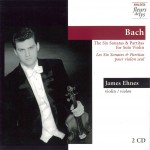
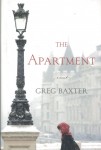 Another book I enjoyed over the recent holidays also led me to my music library. The Apartment (Twelve ISBN978-1-4555-7478-0) by the American author Greg Baxter who now makes his home in Germany, takes place over the period of one day in an unnamed European city. It is a book in which nothing of note happens except in the form of memories of the time the narrator spent in Iraq and of the life he abandoned in the United States. Nevertheless it is a compelling read. The musical interest here is a recital by Japanese violin students where the featured work is the Ciaccona (Chaconne) from Bach’s Partita for Violin No.2. After the recital the narrator strikes up a conversation with Schmetterling, the German violin teacher, who launches into a lecture about how the Ciaccona encompasses “a profundity and intensity heretofore unknown in music. […and which] resulted in the ascension of the violin as the most venerated of all Western instruments.” There are five or six pages devoted to Schmetterling’s appreciation of the work and his claim that “On one stave, for a small instrument, the man writes a whole world of the deepest thoughts and most powerful feelings.” However, he goes on to say “a spiritual sympathy with the piece … [is] … virtually non-existent in violinists under the age of thirty… perhaps forty.” As taken as I was by the elegance and emotion of his speech, this last sounded like a challenge and off I headed to my CD shelves. What I came back with was a favourite of mine, a 2CD set of the Bach Sonatas and Partitas which James Ehnes recorded in 1999 at the tender age of 23 (Analekta FL 2 3147-8). I am quite prepared to accept that his understanding and depth of knowledge of the Ciaccona, and the repertoire in general for that matter, will only increase with time, but I must say that if this early testament is any indication, we can all look forward to a truly awe-inspiring interpretation from Ehnes in the years to come.
Another book I enjoyed over the recent holidays also led me to my music library. The Apartment (Twelve ISBN978-1-4555-7478-0) by the American author Greg Baxter who now makes his home in Germany, takes place over the period of one day in an unnamed European city. It is a book in which nothing of note happens except in the form of memories of the time the narrator spent in Iraq and of the life he abandoned in the United States. Nevertheless it is a compelling read. The musical interest here is a recital by Japanese violin students where the featured work is the Ciaccona (Chaconne) from Bach’s Partita for Violin No.2. After the recital the narrator strikes up a conversation with Schmetterling, the German violin teacher, who launches into a lecture about how the Ciaccona encompasses “a profundity and intensity heretofore unknown in music. […and which] resulted in the ascension of the violin as the most venerated of all Western instruments.” There are five or six pages devoted to Schmetterling’s appreciation of the work and his claim that “On one stave, for a small instrument, the man writes a whole world of the deepest thoughts and most powerful feelings.” However, he goes on to say “a spiritual sympathy with the piece … [is] … virtually non-existent in violinists under the age of thirty… perhaps forty.” As taken as I was by the elegance and emotion of his speech, this last sounded like a challenge and off I headed to my CD shelves. What I came back with was a favourite of mine, a 2CD set of the Bach Sonatas and Partitas which James Ehnes recorded in 1999 at the tender age of 23 (Analekta FL 2 3147-8). I am quite prepared to accept that his understanding and depth of knowledge of the Ciaccona, and the repertoire in general for that matter, will only increase with time, but I must say that if this early testament is any indication, we can all look forward to a truly awe-inspiring interpretation from Ehnes in the years to come.
Music: Books aside, sometimes it’s enough just to focus on the music…
On the eve of Elliott Carter’s 102nd birthday back in December 2010 Toronto’s New Music Concerts presented an evening of his recent works under the banner “Elliott Carter at 102.” Were it not for last minute health and weather complications it would have been Mr. Carter’s seventh visit to Toronto at the invitation of New Music Concerts. As it was, the concert went on as planned – including the world premiere of the Concertino for bass clarinet and chamber orchestra and the Canadian premiere of the Flute Concerto – and the audience was treated to a taped telephone message from the iconic composer expressing his delight. Carter recovered his health and went on to compose most of a dozen more works in the following year and a half before the final illness that led to his death just a month before his 104th birthday. New Music Concerts continued its practice of celebrating the long and creative life of this gentle man with Toronto premieres of Trije glasbeniki in 2011 and the Double Trio in 2012.
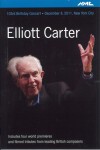 The New York premieres of these two works took place at the 92nd Street Y on December 8, 2011 as part of Elliott Carter’s 103rd Birthday Concert. That festive occasion included world premieres of four new works ranging from Mnemosyne for solo violin (Rolf Schulte) to A Sunbeam’s Architecture, a cycle of six songs on texts by E.E. Cummings for tenor (Nicholas Phan) and large chamber ensemble. The concert, organized by and under the artistic direction of cellist and long-time Carter associate Fred Sherry, has now been released on the British NMC label (NMC DVD193). Other than the solo harp piece Bariolage from 1992, the 12 works featured all date from Carter’s 11th decade. What a treat it is to see Carter fêted in such a creative way and to see the composer’s pleasure in the performances. Still uncompromising in its rhythmic and harmonic complexity, the music is perhaps a bit more approachable than earlier works because of its vigour and gestural exuberance – an amazing testament to Carter’s longevity and joie de vivre.
The New York premieres of these two works took place at the 92nd Street Y on December 8, 2011 as part of Elliott Carter’s 103rd Birthday Concert. That festive occasion included world premieres of four new works ranging from Mnemosyne for solo violin (Rolf Schulte) to A Sunbeam’s Architecture, a cycle of six songs on texts by E.E. Cummings for tenor (Nicholas Phan) and large chamber ensemble. The concert, organized by and under the artistic direction of cellist and long-time Carter associate Fred Sherry, has now been released on the British NMC label (NMC DVD193). Other than the solo harp piece Bariolage from 1992, the 12 works featured all date from Carter’s 11th decade. What a treat it is to see Carter fêted in such a creative way and to see the composer’s pleasure in the performances. Still uncompromising in its rhythmic and harmonic complexity, the music is perhaps a bit more approachable than earlier works because of its vigour and gestural exuberance – an amazing testament to Carter’s longevity and joie de vivre.
The concert concludes with a seemingly spontaneous performance of Happy Birthday and bows from the beaming centenarian. The film continues with moving tributes from leading British composers George Benjamin, Sir Harrison Birtwistle, Alexander Goehr, Oliver Knussen and Colin Matthews. The booklet contains an extensive biography and program notes. This is a wonderful celebration of the artist as an old man for those familiar with the work of Elliott Carter. It would serve as a wonderful point of entry to those who are not.
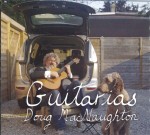 As someone who has spent much of my adult life (folk) singing and accompanying myself on the guitar it strikes me as a bit strange that such a thing is quite rare in the world of Art Song. Of course not many lieder singers accompany themselves on the piano either and I am willing to accept that in the world of classical music it is a life’s work to master even one medium. So it was with pleasure that I received a new disc from Renaissance man Doug MacNaughton on which he accompanies his own distinctive baritone voice with panache on a beautiful-sounding classical guitar constructed by Edward Klein. Guitarias (DougMacNaughton.com) features original works written for MacNaughton by Canadian composers John Beckwith, Leslie Uyeda and William Beauvais (who it seems has also served as guitar teacher and mentor to the singer).
As someone who has spent much of my adult life (folk) singing and accompanying myself on the guitar it strikes me as a bit strange that such a thing is quite rare in the world of Art Song. Of course not many lieder singers accompany themselves on the piano either and I am willing to accept that in the world of classical music it is a life’s work to master even one medium. So it was with pleasure that I received a new disc from Renaissance man Doug MacNaughton on which he accompanies his own distinctive baritone voice with panache on a beautiful-sounding classical guitar constructed by Edward Klein. Guitarias (DougMacNaughton.com) features original works written for MacNaughton by Canadian composers John Beckwith, Leslie Uyeda and William Beauvais (who it seems has also served as guitar teacher and mentor to the singer).
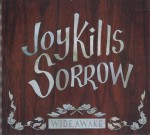 The most immediately appealing work on the album, Shadows, is a collection of songs by British composer John Rutter, best known for his lush choral settings. The appeal however turns out to be from familiarity; his settings of 16th-century poetry sound charmingly anachronistic in their mimicking of lute songs of that era. That being said they are lovely and provide a contrast to the more contemporary sounds of the preceding tracks. Which is not to imply that the other works are not lyrical. Beckwith’s settings of Samuel Beckett’s poetic texts are surprising to this auditor who is more familiar with the bleak prose writings of the Nobel laureate whose motto might well have been the final sentences from The Unnamable: “I can’t go on. I”ll go on.” Uyeda’s Flower Arranger is a gently angular setting of a poignant poem from Joy Kogawa’s collection A Garden of Anchors. The most idiomatic writing for the guitar, not surprisingly, comes from Beauvais in his cycle of songs on texts by Native American poet Linda Hogan. There are occasional extended techniques involved in the guitar writing which MacNaughton handles with apparent ease and without becoming distracted from his lyrical delivery of the vocal lines. I bet he could even walk and chew gum at the same time! My only quibble is the amount of reverb on the recording which seems a bit excessive. All in all though, an impressive solo release from a multi-talented artist. We welcome your feedback and invite submissions. CDs and comments should be sent to: The WholeNote, Centre for Social Innovation, 503 – 720 Bathurst St. Toronto ON M5S 2R4. A quick update on “my favourite band” Joy Kills Sorrow. This exceptional “new grass” band with its roots in Boston’s Berklee School of Music and its Canadian Folk Music Award-winning singer Emma Beaton, returned to grace the stage of Hugh’s Room last month. I admit to some trepidation because a year or so ago one of the mainstays of the band, bass player and award-winning songwriter Brigitte Kearney, left to pursue other interests and I wondered if I would be disappointed. I’m pleased to report that my fears were unfounded. Replacement bass player, Toronto native Zoe Guigueno, proved herself well up to the task and has melded seamlessly with the other members. And to my relief, it seems that Kearney has continued to write with/for the band. In their hour-long set opening for local headliners New Country Rehab there was only one tune from their first two CDs and the new material was uniformly strong and exhilarating.
The most immediately appealing work on the album, Shadows, is a collection of songs by British composer John Rutter, best known for his lush choral settings. The appeal however turns out to be from familiarity; his settings of 16th-century poetry sound charmingly anachronistic in their mimicking of lute songs of that era. That being said they are lovely and provide a contrast to the more contemporary sounds of the preceding tracks. Which is not to imply that the other works are not lyrical. Beckwith’s settings of Samuel Beckett’s poetic texts are surprising to this auditor who is more familiar with the bleak prose writings of the Nobel laureate whose motto might well have been the final sentences from The Unnamable: “I can’t go on. I”ll go on.” Uyeda’s Flower Arranger is a gently angular setting of a poignant poem from Joy Kogawa’s collection A Garden of Anchors. The most idiomatic writing for the guitar, not surprisingly, comes from Beauvais in his cycle of songs on texts by Native American poet Linda Hogan. There are occasional extended techniques involved in the guitar writing which MacNaughton handles with apparent ease and without becoming distracted from his lyrical delivery of the vocal lines. I bet he could even walk and chew gum at the same time! My only quibble is the amount of reverb on the recording which seems a bit excessive. All in all though, an impressive solo release from a multi-talented artist. We welcome your feedback and invite submissions. CDs and comments should be sent to: The WholeNote, Centre for Social Innovation, 503 – 720 Bathurst St. Toronto ON M5S 2R4. A quick update on “my favourite band” Joy Kills Sorrow. This exceptional “new grass” band with its roots in Boston’s Berklee School of Music and its Canadian Folk Music Award-winning singer Emma Beaton, returned to grace the stage of Hugh’s Room last month. I admit to some trepidation because a year or so ago one of the mainstays of the band, bass player and award-winning songwriter Brigitte Kearney, left to pursue other interests and I wondered if I would be disappointed. I’m pleased to report that my fears were unfounded. Replacement bass player, Toronto native Zoe Guigueno, proved herself well up to the task and has melded seamlessly with the other members. And to my relief, it seems that Kearney has continued to write with/for the band. In their hour-long set opening for local headliners New Country Rehab there was only one tune from their first two CDs and the new material was uniformly strong and exhilarating.
A rarity among string bands, Joy Kills Sorrow does not include a fiddle, but the high-octane picking of guitarist Matthew Arcara, banjo player Wes Corbett and, especially, mandolinist Jacob Jolliff hardly give you time to notice. I also noted that the harmony singing by the back benchers has become stronger and more prominent in the past year or two. The new CD Wide Awake (signaturesounds.com) lives up to its name!
Post Script: As we go to print I have just found out that Joy Kills Sorrow’s performance at Hugh’s Room was part of a farewell tour after which the band has decided - amicably it seems - to go their separate ways. I for one will sorely miss them. Who will kill my sorrow now?
David Olds, DISCoveries Editor
discoveries@thewholenote.com.



